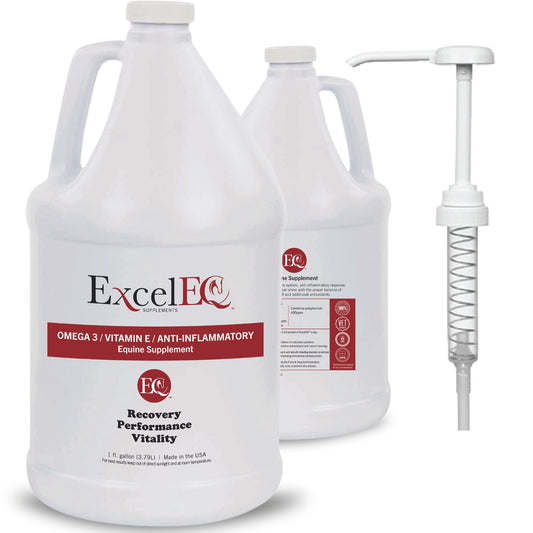Clostridial Myositis in Horses: Symptoms, Risks, and Prevention Tips
Share



Clostridial Myositis/Fasciitis Warning Signs
I was riding across the pasture a few weeks back moving some cattle and just enjoying the day. As I am looking at the cattle head of me I noticed the indention that is shown in the photos above in my mares neck and it brought back some sad memories. This is a home raised filly that is one of my favorites. When she was just a yearling I almost lost her and another colt and did lose her full sister. At the time I did not know what caused the death of her full sister ..... I was making assumptions but was not able to put my finger on it until I talked to the vet in Arizona and read about a case of a horse that was at the vets with Clostridial Myositis/ Fasciitis .... without a shadow of a doubt did I know at this point that this was the reason I had lost my filly and almost two others.
I know this is not related to Excel Supplements but as a horse owner/breeder I sure wish somebody would have told me about this before I lost one of my horses. I want to share it with all of you yet again and hope you pass it on to your horse friends because from the bottom of my heart I hope that nobody has to put one of their horses in the ground because they simply did not know.
SO HERE STARTS THE POST I DID A FEW YEARS AGO ON THIS TOPIC
 I came across some great information that was posted by the Bend Equine Medical Center and found it to important not to share.....I can say this from hands on experience.
I came across some great information that was posted by the Bend Equine Medical Center and found it to important not to share.....I can say this from hands on experience.A couple of winters ago I had two coming yearlings, I Sayo I Love You (in photo above), Ima Smokin Sayo, and a coming two year old filly, Smart N Lil Lena all come up with a bit of a cold after a few days of rain that later turned into a freezing snow. Feeling bad for these guys I brought them in from the pasture and gave them some Banamine to make them feel a bit better. Trying to make the Banamine last longer I thought I would do them a great favor by giving it in the muscle rather then in the vein. Well boy was I wrong.
By the next morning I found Smart N Lil Lena dead in her stall.
Within a few days they all three developed swelling on the side of the neck that I had given the shot to and I Sayo I Love You and Smart N Lil Lena both became very stiff in the neck, carrying their heads low, not eating, and just feeling plumb miserable. By the next morning I found Smart N Lil Lena dead in her stall. I was trying to figure out what happen.....had I gotten something on the needles that I was using? Was it a bad bottle of Banamine? Ima Smokin Sayo's swelling went down a few days after that and he returned to normal. I Sayo I Love you also returned to normal other then a hard lump on her neck. It was not till spring (a few month later) that the hard lump on her neck finally got a soft spot and I lanced it and drained it. All healed well and nothing is left behind from the scare other then a little scar on her neck.
Last winter while I was in Arizona I found myself visiting with a vet there and was telling him about what had happened as I had done with some other vets before but this time I got an answer. He informed me that Clostridial Myositis/Fasciitis is what had happened and how important it is to know that you should NEVER give Banamine in the muscle as you can kill your horse that way. After that I knew better but when I came across this information today I just had to share it as it gives a lot more detail why you should NOT give Banamine in the muscle. So read on and I hope you all get some good out of this and do not have to learn the hard way.
As reported by the Bend Equine Medical Center
 Malcom is a 14 year old Quarter Horse gelding who presented to Bend Equine for a firm swelling on his neck after receiving 10ml of Banamine in the muscle yesterday morning for mild colic symptoms. On presentation Malcom had a fever of 103.5 F, was lethargic and inappetant and the swelling was firm and hot to the touch. On ultrasound the following images were obtained of the swelling. Pockets of fluid and white flecks indicating gas bubbles could be appreciated deep in the muscle. These findings indicate an abscess had formed from an anaerobic bacteria that produces gas (anaerobic bacteria are a type of bacteria that can only survive in environments without air)
Malcom is a 14 year old Quarter Horse gelding who presented to Bend Equine for a firm swelling on his neck after receiving 10ml of Banamine in the muscle yesterday morning for mild colic symptoms. On presentation Malcom had a fever of 103.5 F, was lethargic and inappetant and the swelling was firm and hot to the touch. On ultrasound the following images were obtained of the swelling. Pockets of fluid and white flecks indicating gas bubbles could be appreciated deep in the muscle. These findings indicate an abscess had formed from an anaerobic bacteria that produces gas (anaerobic bacteria are a type of bacteria that can only survive in environments without air) An incision was made via ultrasound guidance deep into the muscle tissue to both drain the abscess and expose the bacteria to air.
An incision was made via ultrasound guidance deep into the muscle tissue to both drain the abscess and expose the bacteria to air. By the end of the week this is what Malcom looked like. Over the course of the next 10 of days Malcom continued to be ill . He was on full ICU supportive care but was still spiking fevers twice daily. Everyday more and more fluid pockets and abscesses could be found on ultrasound and Malcom had to have numerous surgical procedures in attempt to stop the spread of the bacteria and save his life.
By the end of the week this is what Malcom looked like. Over the course of the next 10 of days Malcom continued to be ill . He was on full ICU supportive care but was still spiking fevers twice daily. Everyday more and more fluid pockets and abscesses could be found on ultrasound and Malcom had to have numerous surgical procedures in attempt to stop the spread of the bacteria and save his life.As you can maybe tell by now- this was no ordinary bacteria causing these symptoms! Does anyone have any ideas what is the name of the disease causing Malcom’s illness? What are the predisposing factors for this type of disease?
Here is your Answer
Why to NEVER, EVER administer Banamine into the muscle of a horse….
This disease is called Clostridial Myositis/Fasciitis secondary to intra-muscular administration of Banamine. Clostridial Myositis (also known as gas gangrene) is a very rare disease however it is far more likely to occur when certain substances are injected into the muscle. The top 3 culprits are Banamine (flunixin meglumine), ivermectin and anti-histamines. Clostridium is a bacteria which spores exist everywhere in our environment- soil, skin, debris etc. Once the spores sense that they are in an environment without air (such as after being injected into a muscle) they sporulate, reproduce and start to produce exotoxin. This exotoxin is extremely toxic to the surrounding tissue causing death and massive inflammatory reactions of the muscle, skin and whole body. The Clostridium bacteria spreads rapidly and causes the horse to become very systemically ill. Surgical exposure of the bacteria to oxygen, appropriate antibiotics, and supportive care are the cornerstones of therapy however, even with the best of care 40-70% of these horses will die or be euthanized. Those that survive acquire thousands of dollars of hospital bills and endure a long and painful illness.
The veterinary community does not fully understand the mechanism for why these drugs cause this particular infection however it is related to the fact that they are all severely irritating substances that cause a significant amount of local inflammation when injected intramuscularly. Very unfortunately, Banamine is labeled for intramuscular use in horses and owners/trainers who have access to injectable Banamine may read this and think that it is safe to administer it with this method. The take home message of this case report is NEVER, EVER administer Banamine in the muscle of a horse! If you cannot properly administer Banamine into a vein than oral use of the drug is the only method it should be given.
We are happy to report that with a tremendous amount veterinary care, wonderfully supportive owners and a 3-week stay at Bend Equine, Malcolm survived his infection and went home happy and healthy!
UPDATE
 This is a picture of Malcolm just before he went home! There are a few things that Bend Equine Medical Clinic added in regards to this topic.
This is a picture of Malcolm just before he went home! There are a few things that Bend Equine Medical Clinic added in regards to this topic.1) Clostridial Myositis is NOT a condition where an injection site abscess is left to sit too long and gets out of control. These owners brought this horse in at the slightest hint of swelling and he was treated immediately. This is a special kind of bacteria that is particularly fast spreading and dangerous. As mentioned in your responses, it can occur with other types of injectables however it is FAR more likely to happen with Banamine due to the highly inflammatory nature of it.
2) Believe it or not, proper cleaning of the injection site does not reduce the risk of this disease from occurring- we wish it were that simple! We of course encourage cleaning an injection site and recommend ALWAYS using clean needles however this injection was given properly with a clean needle by an experienced owner and no negligence was to blame which is why this is an important topic to get out there!
3) It is a common occurrence for horses to develop localized swelling at an injection site (ie after vaccines) We do not wish to cause undo fear in people with this case. Clostridial infections are no ordinary injection site abscess/inflammation and they are most commonly associated with intramuscular Banamine injections. We encourage you to take injection site inflammation seriously and have your horse seen by a veterinarian should it occur.






